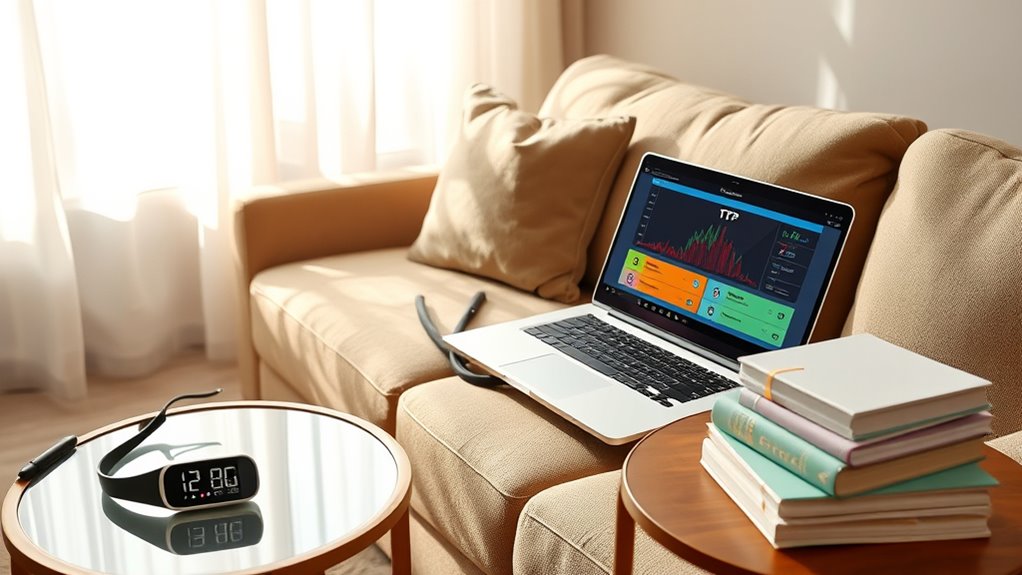To perform an FTP test at home, warm up for 10-15 minutes at low intensity, ensuring your bike setup is consistent and your equipment is properly calibrated. Ride at your maximum sustainable effort for 20 minutes, maintaining a steady pace without surges. Afterward, cool down for at least 10 minutes. Stay attentive to secure, encrypted data transfers to protect your results. Keep these steps in mind as you explore detailed tips for accurate testing.
Key Takeaways
- Warm up for 10-15 minutes at low intensity to prepare muscles and ensure consistent bike setup.
- Perform a 20-minute all-out effort maintaining steady power without surges.
- Use a reliable power meter or smart trainer to monitor and record your power output accurately.
- Cool down for at least 10 minutes after the test to aid recovery and data stability.
- Calculate FTP by multiplying the 20-minute average power by 0.95 for your functional threshold.

Testing your FTP at home is a practical way to gauge your cycling fitness without visiting a lab or gym. It provides valuable insight into your current performance level, helping you tailor your training for better results. Before you start, ensure your bike setup is consistent each time. Use a reliable power meter or smart trainer to measure your data transfer accurately, as this data forms the foundation of your FTP calculation. It’s important to consider network security when connecting your devices; ensure your wireless connections are secure to prevent interference or data breaches that could compromise your workout data. Secure data transfer not only protects your personal information but also guarantees that your FTP results are precise and trustworthy.
Begin by warming up thoroughly for about 10 to 15 minutes at a low intensity. This prepares your muscles and cardiovascular system, ensuring your effort during the test is consistent and reliable. Once warmed up, find a flat, open space free from distractions. The standard FTP test involves riding at your maximum sustainable effort for 20 minutes. During this period, focus on maintaining a steady pace without surging or slowing down. Use your device to monitor your power output continuously, paying attention to your data transfer rate to ensure the readings are consistent. Keep your effort level high but controlled to avoid premature fatigue, which can skew your results. Additionally, choosing the right training environment can greatly impact your test accuracy and comfort.
Begin with a 10-15 minute low-intensity warm-up to ensure consistent effort during your FTP test.
Throughout the test, remain vigilant about your network security. If you’re using a smart trainer or online platform, make sure your connection is encrypted and protected from potential cyber threats. A stable, secure connection guarantees that the data transfer between your device and the platform isn’t interrupted, preventing data loss or inaccuracies. After completing the 20-minute effort, cool down for at least 10 minutes at a relaxed pace. This helps your body recover and prevents injury or excessive fatigue from the intense effort.
To determine your FTP, take the average power output over the 20-minute segment, then multiply it by 0.95. This calculation provides an estimate of your functional threshold power, which you can use to set training zones and track your progress. Remember, consistency is key—perform the test under similar conditions each time to get comparable results. By paying attention to data transfer integrity and maintaining secure network practices, you’ll ensure your FTP testing at home is both accurate and safe, giving you a reliable benchmark to improve your cycling performance.
Frequently Asked Questions
What Equipment Is Needed for At-Home FTP Testing?
To perform at-home FTP testing, you need the equipment essentials for your testing setup. This includes a reliable bike trainer, a speed/cadence sensor, a heart rate monitor, and a device to run your testing app or software. Make certain your bike is compatible, and your devices are connected securely. Having a stable internet connection is also vital to guarantee accurate data collection and smooth testing.
How Often Should I Perform an FTP Test?
You should perform an FTP test every 6 to 8 weeks to track your progress effectively. Incorporate seasonal testing into your training frequency, adjusting based on your training cycle and goals. Regular testing helps you fine-tune your training intensity and monitor improvements. Be consistent with your schedule, and make certain you rest adequately between tests to get accurate results and optimize your training plan.
Can Beginners Accurately Perform FTP Testing at Home?
Performing an FTP test at home is like climbing a small hill—you can do it, but it takes some effort. As a beginner, you can accurately perform it if you follow clear training resources and start with basic techniques. While advanced techniques might come later, focus on maintaining steady effort during the test. With patience and proper guidance, you’ll get reliable results that help improve your cycling.
How Do I Interpret My FTP Test Results?
You interpret your FTP test results by looking at your power output during the test and comparing it to performance benchmarks. If your power is high, it indicates strong fitness. Use your FTP number to set training zones and measure progress over time. Remember, consistent improvements in power output show you’re getting fitter, so track your results regularly to adjust your training plan effectively.
What Should I Do if My FTP Results Are Inconsistent?
Imagine your FTP results flickering like a faulty light bulb—unexpected inconsistencies can be frustrating. To address this, review your training resources for proper testing techniques and verify you’re following a consistent routine. Seek community feedback to compare your results and identify patterns. Adjust your training plan accordingly, stay patient, and remember that occasional fluctuations are normal. Keeping a detailed log helps track progress despite these variations.
Conclusion
By following these simple steps, you’ll discover that FTP testing at home isn’t just possible—it’s almost inevitable. As you set your pace and track your progress, it’s funny how improvements seem to align with your efforts, almost as if the universe conspired to reward your dedication. So, keep pushing forward, and remember—what feels like a coincidence might just be the start of your next cycling breakthrough.









